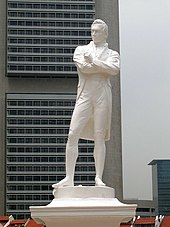

The history of Singapore dates to the 11th century. The island rose in importance during the 14th century under the rule of Srivijayan princeParameswara and became a port until it was destroyed by Acehnese raiders in 1613
During World War II, Singapore was conquered and occupied by the Japanese Empire from 1942 to 1945. When the war ended, Singapore reverted to British control, with increasing levels of self-government being granted, culminating in Singapore's merger with the Federation of Malaya to formMalaysia in 1963. However, social unrest and disputes between Singapore's ruling People's Action Party and Malaysia's Alliance Party resulted in Singapore's separation from Malaysia. Singapore became an independent republic on 9 August 1965.
Facing severe unemployment and a housing crisis, Singapore embarked on a modernisation programme that focused on establishing a manufacturing industry, developing large public housing estates and investing heavily on public education. Since independence, Singapore's economy has grown by an average of nine percent each year. By the 1990s, the country had become one of the world's most prosperous nations, with a highly developed free market economy, strong international trading links, and the highest per capita gross domestic product in Asia outside of Japan.
The earliest written record of Singapore occurs in a Chinese account from the third century, describing the island of Pu Luo Chung (蒲 罗 中). This was itself a transliteration from the Malay name "Pulau Ujong", or "island at the end" (of the Malay Peninsula). The quasi-mythological Sejarah Melayu (Malay Annals) contains a tale of a prince of Srivijaya, Sri Tri Buana (also known as Sang Nila Utama), who landed on the island during the 13th century. When he saw a lion, the prince took this as an auspicious sign and founded a settlement called Singapura, which means "Lion City" in Malay. However, it is unlikely there ever were lions in Singapore, though tigers continued to roam the island until the early 20th century. As part of the Sri Vijaya Empire, Singapore was invaded by the south Indian Emperor Rajendra Chola I of the Chola Empire in the 11th century.
In 1320, the Mongol Empire sent a trade mission to a place called Long Ya Men (or Dragon's Tooth Strait), which is believed to be Keppel Harbour, at the southern part of the island. The Chinese traveler Wang Dayuan, visiting the island around 1330, described a small settlement called Dan Ma Xi (淡马锡, from Malay Tamasik) with Malay and Chinese residents. The Nagarakretagama, a Javanese epic poem written in 1365, also referred to a settlement on the island called Temasek (Sea Town). Recent excavations in Fort Canning found evidence indicating that Singapore was an important port in the 14th century..
Between the 16th and 19th centuries, the Malay Archipelago was gradually taken over by the European colonial powers, beginning with the arrival of thePortuguese at Malacca in 1509. The early dominance of the Portuguese was challenged during the 17th century by the Dutch, who came to control most of the ports in the region. The Dutch established a monopoly over trade within the archipelago, particularly in spices, then the region's most important product. Other colonial powers, including the British, were limited to a relatively minor presence.
In 1818, Sir Stamford Raffles was appointed as the Lieutenant Governor of the British colony at Bencoolen. He was determined that Great Britain should replace the Netherlands as the dominant power in the archipelago, since the trade route between China and British India, which had become vitally important with the institution of the opium trade with China, passed through the archipelago. The Dutch had been stifling British trade in the region by prohibiting the British from operating in Dutch-controlled ports or by subjecting them to a high tariff. Raffles hoped to challenge the Dutch by establishing a new port along the Straits of Malacca, the main ship passageway for the India-China trade. He convinced Lord Hastings, the Governor-General of India and his superior at the British East India Company, to fund an expedition to seek a new British base in the region.
Raffles arrived in Singapore on 28 January 1819 and soon recognized the island as a natural choice for the new port. It lay at the southern tip of the Malay peninsula, near the Straits of Malacca, and possessed a natural deep harbor, fresh water supplies, and timber for repairing ships. Raffles found a small Malay settlement, with a population of a few hundred, at the mouth of the Singapore River, headed by Temenggong Abdu'r Rahman. The island was nominally ruled by the Sultan of Johor, who was controlled by the Dutch and the Bugis. However, the Sultanate was weakened by factional division and Temenggong Abdu'r Rahman and his officials were loyal to Tengkoo Rahman's elder brother Tengku Hussein (or Tengku Long) who was living in exile in Riau. With the Temenggong's help, Raffles managed to smuggle Hussein back into Singapore. He offered to recognize Hussein as the rightful Sultan of Johor and provide him with a yearly payment; in return, Hussein would grant the British the right to establish a trading post on Singapore. A formal treaty was signed on 6 February 1819 and modern Singapore was born.
Before Raffles arrived, there were around 1,000 people living in Singapore, mostly Malays and a few dozen Chinese. By 1869, due to migration from Malayaand other parts of Asia, Singapore's population had reached 100,000. Many Chinese and Indian immigrants came to Singapore to work in the rubber plantations and tin mines, and their descendents later formed the bulk of Singapore's population.


